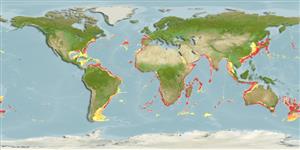(كوسه ها و سپرماهيان) (sharks and rays) >
Lamniformes (Mackerel sharks) >
Mitsukurinidae (Goblin shark)
Etymology: Mitsukurina: -ina (L.), belonging to: University of Tokyo zoologist Kakichi Mitsukuri (1858-1909), who placed holotype (provided by Alan Owson, see species) of this “very remarkable shark” in Jordan’s “hands to be identified, figured, and described”. (See ETYFish); owstoni: In honor of Alan Owston (1853-1915), English businessman, yachtsman, collector of Asian wildlife, and resident of Yokohama, Japan, who secured holotype from a fisherman (named for Owston at the request of Kakichi Mitsukuri, see genus). (See ETYFish).
More on author: Jordan.
Environment: milieu / climate zone / depth range / distribution range
بوم شناسي
دريايي موجوداتی که در اعماق زیر 200 متر زندگی و تغذیه می کنند; تغييرات عمق 30 - 1300 m (Ref. 43278), usually 270 - 960 m (Ref. 43278). Deep-water; 48°N - 55°S, 180°W - 180°E
Western Atlantic: Guyana (Ref. 6871), Suriname (Ref. 13608, 11228) and French Guiana. Eastern Atlantic: France (Bay of Biscay), Madeira, Portugal, and South Africa. Western Indian Ocean: off South Africa. Western Pacific: Japan, Australia (South Australia, New South Wales), New Zealand (Ref. 26346). Eastern Pacific: USA (southern California) (Ref. 43278).
Length at first maturity / Size / Weight / سن
Maturity: Lm 293.0, range 264 - 322 cm
Max length : 617 cm TL جنس نر / بدون خواص جنسي; (Ref. 83323); common length : 200 cm TL جنس نر / بدون خواص جنسي; (Ref. 5217)
خارهاي باله پشتي (کل) : 0; خارهاي باله مخرجي: 0. Flat, bladelike, elongated snout, tiny eyes without nictitating eyelids, soft, flabby body, slender, very long cusped teeth in long, protrusible jaws, long caudal fin without a ventral lobe (Ref. 247). Pinkish-white with bluish fins, becoming brownish grey after death (Ref. 5578, 11228).
Found on outer continental shelves and upper slopes, but rarely in shallow water close inshore (Ref. 247, 43278). Jaws are highly specialized for rapid projection from the head to snap up small animals (Ref. 247). Feeds on jacopever, pelagic octopus and crabs (Ref. 5578). Ovoviviparous, embryos feeding on yolk sac and other ova produced by the mother (Ref. 50449). Probably slow-moving and neutrally buoyant (Ref. 6871). Utilized dried salted (Ref. 247)
Life cycle and mating behavior
Maturities | تولید مثل | Spawnings | Egg(s) | Fecundities | توزاد ( لارو)
Exhibit ovoviparity (aplacental viviparity), with embryos feeding on other ova produced by the mother (oophagy) after the yolk sac is absorbed (Ref. 247, 50449). Distinct pairing with embrace (Ref. 205).
Compagno, L.J.V., 1984. FAO Species Catalogue. Vol. 4. Sharks of the world. An annotated and illustrated catalogue of shark species known to date. Part 1 - Hexanchiformes to Lamniformes. FAO Fish. Synop. 125(4/1):1-249. Rome, FAO. (Ref. 247)
وضعيت در فهرست قرمز IUCN (Ref. 130435)
استفاده انسانی
ابزارها
گزارش های ويژه
بارگيری XML
منابع اينترنتي
Estimates based on models
Preferred temperature (Ref.
123201): 3.8 - 13.7, mean 8.3 °C (based on 1037 cells).
Phylogenetic diversity index (Ref.
82804): PD
50 = 1.5000 [Uniqueness, from 0.5 = low to 2.0 = high].
Bayesian length-weight: a=0.00389 (0.00180 - 0.00842), b=3.12 (2.94 - 3.30), in cm total length, based on all LWR estimates for this body shape (Ref.
93245).
Trophic level (Ref.
69278): 4.1 ±0.62 se; based on food items.
جهندگی (Ref.
120179): خیلی آهسته, كمينه زمان لازم براي دو برابر شدن جمعيت بيش از 14 سال (Fec assumed to be <10).
Fishing Vulnerability (Ref.
59153): Very high vulnerability (90 of 100).
